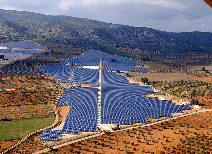Parc photovoltaique, financial dream or nightmare?
|
Harry Morskate | 7 januar 2011 |
In 2005
a 'Parc Eolien' was built in
our community, despite the objections of a significant number of
residents for noise pollution and damage of nature. The concerns were
easily brushed aside by our mayor, mainly on the grounds that «the
financial benefit" would be a good contribution to our community».
Now we know that:
According to the major national environmental plan, France must have at the end of 2012 1,100 megawatts of solar-generated power. With numerous projects submitted would it even be 3,000 megawatts. Just like the German example, the Ministry of Economic Affairs likes tot link the subsidy rates to the number of projects waiting for approval, a form of restriction. The yearly extension may not be more than an average of 500 megawatts generated by all parties including individuals, corporations and 'solar farms'. The very high price of 58 centimes by kilowatt (one of the highest in Europe) who private generators now receive, cost the EDF too much money and can not be funded in the growing range. All customers of EDF to pay extra towards the development of new forms of production through the CSPE, Contribution au service public de l'électricité.) |
For
the
additional cost of many new applications to keep paying the bills for
all EDF customers would be increased by 10% to go. EDF sells
electricity at an average price of 10 centimes by kilowatt. And if private generators would exceed their quarterly quota the EDF subsisie rate should automatically go down by a factor that is related to the amount of the excess. The Ministry intends to negotiate on the basis of a rate 10% lower than the current rate for individuals of 58 centimes per kilowatt. The major generators of solar power, such as malls and farms would be covered under a similar system. The new subsidy rates for 2012:
It is therefore important that all residents of the community are well informed. Not only about the decisions, the degradation of nature, the potential conflict of interest, but also about the usefulness and possible financial returns and risks. This is to prevent that it is going the same way as to the Parc Eolien. Disruption and degradation of nature and no revenue for the inhabitants of our, still beautiful, community. |




